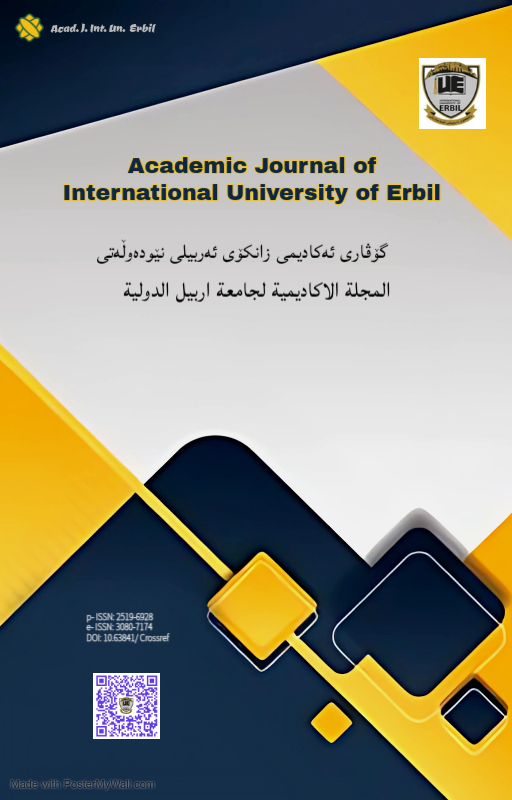The Impact of Organizational Integrity on Organizational Symmetry: An Analytical Study in the Public and Private Sectors
Impact of Organizational Integrity on Organizational Symmetry
DOI:
https://doi.org/10.63841/iue22524Keywords:
Organizational Integrity, Organizational Symmetry, Optimism, Empathy, Trust, Tolerance, Loyalty, Similarity, MembershipAbstract
This study aims to determine the effect of organizational Integrity, represented by the dimensions of (Optimism, Trust, Empathy, and Tolerance) on organizational Symmetry, represented by (Loyalty, Similarity, and Membership) in the public and private sectors in the KRI. Researchers used probability sampling to collect the data via a Google form (n = 144) using SPSS software V.26. Data were analyzed using descriptive statistics to find the frequencies and percentages of the demographic questions. The Chi-Square Test was used to find the association relationship between variables; researchers used Spearman’s rank-order correlation and regression analysis to show the correlation and the impact of organizational Integrity on organizational Symmetry. Results show no statistical relationship between demographic variables and respondents' opinions about how Integrity affected organizational Symmetry. A positive and significant correlation exists between organizational integrity and organizational Symmetry. In addition, results show that there is a statistically significant effect of organizational Integrity (Empathy and Tolerance) on organizational Symmetry (Loyalty and Similarity) and there is a statistically significant effect of one of the dimensions of organizational Integrity (Tolerance) on one of the dimensions of organizational Symmetry (Membership).
References
H. J. Silverman, “Organizational ethics in healthcare organizations: proactively managing the ethical climate to ensure organizational integrity, ” HEC Forum, vol. 12, no. 3, pp. 202-2015, 2000.
M. Kaptein, “The diamond of managerial integrity,” European Management Journa, vol. 21, no. 1, pp. 99-108, 2003.
J. D.Rendtorff, “Corporate citizenship as organizational integrity. in Corporate citizenship and new governance: The political role of corporations, ” springer, pp. pp.59-90, 2011.
D. Ein-Gar, “Committing under the shadow of tomorrow: Self-control and commitment to future virtuous behaviors, ” Journal of Consumer Psychology, vol. 2, no. 25, pp. 268-285, 2015.
M. Meyer, “The evolution and challenges of the concept of organizational virtuousness in positive organizational scholarship, ” Journal of Business Ethics vol. 153, pp. 245-264, 2018.
X. Zeng, “Development of framework linking organizational virtuousness and pro-social rule breaking: from the perspective of social information processing, ”Open Journal of Social Science, vol. 6, no. 6, pp. 80-89, 2018.
S. A. Saeed, S. O. Ali, and K. M. Rashid, K.M, “The Effect of Different Leadership Styles on Job Satisfaction, ”Organization and Human Capital Development, vol. 2, no.2, pp. 16-30, 2023.
D. S. Bright, K. S. Cameron, and A. Caza, A, “The amplifying and buffering effects of virtuousness in downsized organizations, ”Journal of Business Ethics, vol. 64, pp. 249-269, 2006.
T. P. Searle, and J. E. Barbuto, “Servant leadership, hope, and organizational virtuousness: A framework exploring positive micro and macro behaviors and performance impact, ”Journal of Leadership & Organizational Studies, vol. 1, no. 18, pp. 107-117, 2011.
W. M. Hur, Y. Shin, S. Y., Rhee, and H. Kim, “Organizational virtuousness perceptions and task crafting: The mediating roles of organizational identification and work engagement, ”Career Development International, vol. 4, no. 22, pp. 436-459, 2017.
S. A. Saeed, “The Effects of Knowledge Management Practices on Organizational Performance: A Case Study of Halabja University, ”Near East University Graduate School of Social Sciences Innovation and Knowledge Management Master's Programme, 2017.
J. W. Ciarrocchi, and E. Deneke, “Hope, optimism, pessimism, and spirituality as predictors of well-being controlling for personality, ”Research in the social scientific study of religion, vol. 16, pp. 161-183, 2005
M. Ravaji, and Ali Akbar Ghahremani Golouzan, “The Effect of Organizational Virtuousness and Psychological Capital Role on Employees' Creativity In Tehran Water and Wastewater Company, ”International Journal of Scientific Management & Development, vol. 4, no.12, pp. 496, 2016.
K. S. Cameron, and A. Caza, “Virtuousness as a source of happiness in organizations, ”in Oxford Handbook of Happiness, Oxford, U.K.: Oxford University Press., pp. 676–692, 2013
K. Cameron, and M. Lavine, “Making the impossible possible: Leading extraordinary performance: The Rocky Flats story, ” Berrett-Koehler Publishers, pp. 254, 2006.
H. Blbas, and S. H. Mahmood., “A Comparison results of factor analysis and cluster analysis to the migration of young people from the Kurdistan Region to Europe, ” ZANCO Journal of Pure and Applied Sciences, vol. 4, no.29, pp. 44-55, 2017.
F. Semerciöz, M. Hassan, and Z. Aldemir, “An empirical study on the role of interpersonal and institutional trust in organizational innovativeness, ”International Business Research, vol. 2, no.4, pp. 125-136, 2011.
F. Özen, “On the Intermediary Effect of Organizational Policy: The Effect of Perceived Ethical Climate on Corruption Behavior of Teachers,”Journal of Education and Training Studies, vol. 6, no.8 , pp. 52-65, 2018.
J. H. Rafik, and M.Y. Al-Hashmawi, “Ethical Leadership and its Impact on Organizational Integrity: Analytical research at Sumer University, ”International Journal of Research in Social Sciences & Humanities, vol. 12, no.4, pp. 540-562, 2022.
S. Z. Malik, and R. Naeem, “Organizational virtuousness, perceived organizational support and organizational citizenship behavior: A mediation framework, ”Journal of Behavioural Sciences, vol. 26, no.1, pp. 113-129, 2016.
K. M. Saleh, “The effect of constructive conflict on organizational Symmetry, applied research in the Iraqi Ministry of Planning,”unpublished Master's thesis, University of Baghdad, ’ (College of Administration and Economics—department of Public Admin, 2014).
S. A. M. Al-Bashabsha,“The impact of organizational justice in crystallizing organizational Symmetry in Jordanian public institutions, a field study, ”Jordanian Journal of Business Administration, vol. 4, no.4, 2020.
B. E. Ashforth, S. H. Harrison, and K. G. Corey, G.K, “Identification in Organization: An Examination of Four Fundamental Questions,” Journal Management, vol. 34, no.3, 2008. 10.1177/014920630831
M. Çeri-Booms, “How can authentic leaders create organizational identification? An empirical study on Turkish employees, ” International Journal of Leadership Studies, vol. 7, no. 2, pp. 172-190, 2012.
W. L., Johnson, A.M, Johnson, and F. Heimberg,“A primary and Secondary order component analysis of the organizational identification questionnaire, ”Educational and Psychological Measurement, vol.5, no.1, pp. 159-170, 1999.
M. R. Edwards, and R. Peccei, “Organizational Identification: Development and Testing of a Conceptually Grounded Measure, ”European Journal of Work and Organizational Psychology, vol. 16, no.1, pp. 25–57, 2017.
D. Todorović, M. Čabarkapa, M. Tošić-Radev, and I. Miladinović, “Organizational identification, commitment and orientations of professional military personnell, ”Vojnosanitetski pregled, , vol. 74, no.9, pp.8 71-877, 2017.
R. Puutio, V. L. Kykyri, and J. Wahlström, “Constructing asymmetry and symmetry in relationships within a consulting system, ”Systemic Practice and Action Research, vol.21, pp. 35-54, 2008.
M. M. S. Alsayed, “The Effect of leadership in values on organizational loyalty: Analytical Theoretical Study, ” RIMAK International Journal of Humanities and Social Sciences, vol. 2, no. 4, pp. 92-102, 2020.
K. A. Khudair, “Organizational trust and its role in enhancing organizational loyalty, an applied study of the number of employees in the branches of Al-Rafidain Bank in the Najaf Governorate,” Al-Gharbi Journal of Administrative and Economic Sciences, vol.8, no. 31, pp. 66, 2014.
C. Pandey, and R. Khare, “Impact of job satisfaction and organizational commitment on employee loyalty, ”International Journal of Social Science & Interdisciplinary Research, vol. 1, no.8, pp. 26-41, 2012.
F. A. Mael, and B. E. Ashforth, “Identification in work, war, sports, and religion: Contrasting the benefits and risks, ”Journal for the Theory of Social Behaviour, vol. 31, no. 2, pp. 197-222, 2001.
A. A. Al-Ani, and S. N. Al-Sarraf, “Measuring the level of organizational Symmetry for individuals working in the University of Mosul: a field study,” Anbar university Journal for Economic and Administrative Sciences, vol. 11, no. 24, pp. 48, 2019.
M. A. A. Al-Khalifat, “The impact of practicing leadership skills on developing organizational Symmetry in Jordanian public institutions, ” (Master's thesis, Department of Public Administration, Mu’tah University, pp. 42, 2006.
N. H. A Ahmed, “Soft Leadership Skills and their Role in Organizational Symmetry / An Analytical Study of the Opinions of a Sample of Faculty Members in Public Universities in Dohuk Governorate, ” ( Unpublished Master’s Thesis, Zakho University, College of Administration and Economics, Department Business Administration, , Kurdistan Region of Iraq, pp. 96, 2016.
A. A. S. Abdel-Daiem, “The role of organizational Symmetry in developing social capital. An analytical study on a sample of employees of the Ministry of Health / Baghdad Health Authority Al-Karkh, ” Iraqi University Journal, vol. 36, no. 1, pp. 444, 2016.
S. L. Nicola, , and S. M. Faraj, “Should I stay, or should I go? Migration attitudes after the financial crisis (2014–19) among students from Halabja (KRI), ” Journal of Contemporary Iraq & the Arab World, vol. 14, no. 3, pp. 201-222, 2020.
H. Blbas, “Statistical analysis for the most influential reasons for divorce between men and women in Erbil-Iraq, ” International Journal. Malmö, Sweden, vol. 6, no. 2, pp. 207-216, 2019.
H. T. Blbas, and S. M. Faraj, “A statistical study of the influence of COVID-19 on the agricultural supply chain (vegetative) production in Halabja governorate,” Cihan University-Erbil Scientific Journal, vol. 6, no. 1, pp. 1-6, 2022.
H. T. Blbas, S. H. Mahmood, and C. A. Omer, “A Comparison results of factor analysis and cluster analysis to the migration of young people from the Kurdistan Region to Europe, ” ZANCO Journal of Pure and Applied Sciences, vol. 29, no. 4, pp. 44-55, 2017.
A. Omer, S. M. Faraj, and S. H. Mohamad, “An application of two classification methods: hierarchical clustering and factor analysis to the plays PUBG, ” Iraqi Journal of Statistical Sciences, vol. 20, no. 1, pp. 25-42, 2023.
K. Pearson, “X. On the criterion that a given system of deviations from the probable in the case of a correlated system of variables is such that it can be reasonably supposed to have arisen from random sampling, ” The London, Edinburgh, and Dublin Philosophical Magazine and Journal of Science, vol. 50, no. 302, pp. 157-175, 1900.
H. O. Saadi, H. S. Sdeeq, M. M. Hussein, H. T. Blbas, K. Qadir, and S. M. Muhammed, S.M, “Umbilical Cord Care Knowledge and Practice among Sample of Kurdish Women, ” Technium BioChemMed, vol. 6, pp. 41-55, 2023.
K. Aroian, N. Uddin, and H. Blbas, “Longitudinal study of stress, social support, and depression in married Arab immigrant women” Health care for women international, vol. 38, no. 2, pp. 100-117, 2017.
H. T. A. Blbas, W. T. S. Kahwachi, S. K. Ahmed, K. G. Aziz, S. M. Faraj, and M. S. Mohammed, “Factors contributing to vitamin D deficiency in Erbil, Iraq: A statistical investigation, ” Clinical Nutrition Open Science, vol. 54, pp. 151-162, 2024.
S. M. Faraj, and M. M. Jafr, “The Relationship and Effect of Social Media on Student’s Academic Performance:-University of Halabja as an Example, ” Halabja University Journal, vol. 5, no. 4, pp. 326-339, 2020.
S. Ahmed, S. Abdulqadir, R. M. Omer, S. Hussein, K. Qurbani, M. Mohamed, and H. Blbas, M. Fahrni, A. Lazzarino “Knowledge, Attitudes, and Willingness to Vaccinate for Mpox among Healthcare Workers in Kurdistan Region of Iraq: A Nationwide Cross-Sectional Study” Vaccines, vol. 11, no. 12, pp. 1734, 2023.
H. T. Blbas, and W. T. Kahwachi, “A Comparison Between New Modification of Adaptive Nadaraya-Watson Kernel and Classical Adaptive Nadaraya-Watson Kernel Methods in Nonparametric Regression, ” Cihan University-Erbil Scientific Journal, vol. 5, no. 2, pp. 32-37, 2021.
M. Udovičić, K. Baždarić, L. Bilić-Zulle, and M. Petrovečki, “What we need to know when calculating the coefficient of correlation?, ” Biochemia Medica, vol. 17, no. 1, pp. 10-15, 2007.
K. G. Aziz, S. A. Saeed, and S. M. Faraj, “The influence of leadership style, work discipline, and job satisfaction on employee motivation, ” Turkish Online Journal of Qualitative Inquiry, vol. 13, no. 1, 2022.
B. Beers, and S. Anderson, “Regression definition,” Retrieved from Investopedia: https://www. investopedia. com/terms/r/regression. asp, 2021
H. T. Blbas, “Descriptive Statistics, ”Recent Advances in Biostatistics’ (IntechOpen, 2024)
Downloads
Published
Issue
Section
License
Copyright (c) 2025 Academic Journal of International University of Erbil

This work is licensed under a Creative Commons Attribution 4.0 International License.












